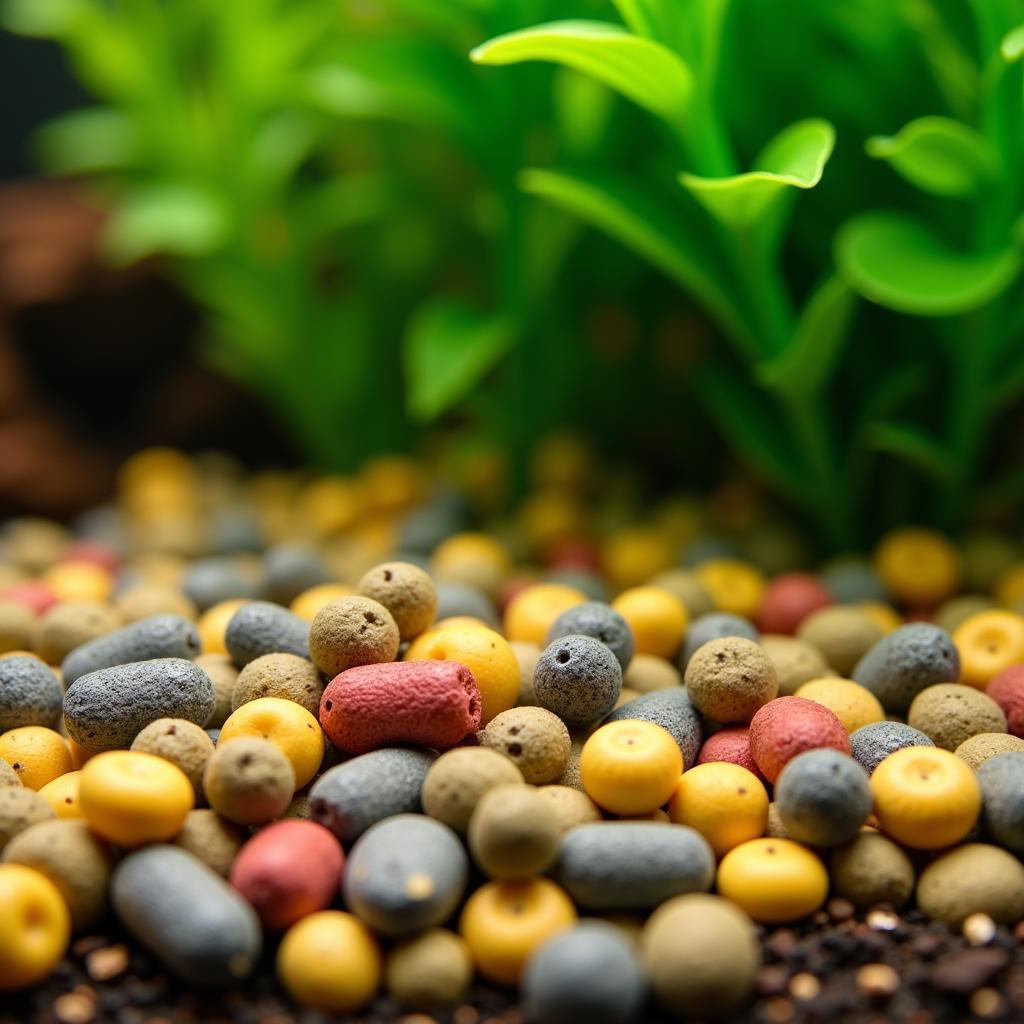Sinking Fish Food Pellets are a staple for many aquarium owners. These slow-descending pellets offer a convenient and effective way to ensure your fish receive the nutrients they need to thrive. But with so many options available, choosing the right sinking fish food pellets can feel overwhelming.
Why Choose Sinking Fish Food Pellets?
Unlike floating pellets that remain at the surface, sinking pellets cater to bottom-feeding fish species. These pellets slowly descend through the water column, mimicking the natural foraging behavior of fish like catfish, loaches, and certain types of cichlids.
 Sinking pellets in an aquarium
Sinking pellets in an aquarium
Benefits of Sinking Pellets
Sinking fish food pellets provide numerous benefits for both your fish and your aquarium:
- Targeted Feeding: They allow you to feed bottom-dwelling fish directly without overfeeding surface feeders.
- Reduced Waste: Sinking pellets are less likely to be drawn into filters, leading to cleaner water and less frequent maintenance.
- Improved Digestion: The slow descent allows fish ample time to consume the pellets fully, reducing the risk of digestive issues.
- Nutritional Value: Sinking pellets are often packed with essential proteins, vitamins, and minerals for healthy growth and vibrant coloration.
Choosing the Right Sinking Pellets
Selecting the appropriate sinking fish food pellets is crucial for your fish’s well-being. Consider these factors when making your choice:
- Fish Species: Different species have unique dietary needs. Research the specific requirements of your fish before selecting a pellet type. For instance, swan food pellets are formulated for swans and might not be suitable for your aquarium fish.
- Pellet Size: Opt for pellets that your fish can comfortably consume. Smaller fish require smaller pellets, while larger species need larger sizes.
- Ingredient Quality: Look for pellets with high-quality protein sources, such as fish meal, krill, or insect larvae. Avoid fillers like wheat or corn.
Understanding Pellet Composition
A pellet’s ingredients directly impact its nutritional value and how it affects your aquarium water.
- Protein: The primary building block for fish growth, protein should make up a significant portion of the pellet.
- Fats: Provide essential fatty acids for energy and overall health.
- Fiber: Aids in digestion and helps prevent constipation in fish.
- Vitamins and Minerals: Essential for various bodily functions, including immune system support and bone health.
Feeding Sinking Pellets Effectively
Even the best sinking fish food pellets won’t benefit your fish if not offered correctly.
- Frequency: Most adult fish thrive on one feeding per day. However, smaller or younger fish might benefit from two smaller feedings.
- Quantity: Offer only as much food as your fish can consume within a few minutes. Overfeeding pollutes the water and can lead to health issues.
- Observation: Observe your fish during feeding time. Adjust the quantity and frequency based on their appetite and how quickly they consume the pellets.
Common Concerns with Sinking Pellets
Do Sinking Pellets Cloud Water?
High-quality sinking pellets should not significantly cloud your aquarium water. If you notice excessive cloudiness, it might indicate overfeeding, poor-quality pellets, or an issue with your filtration system.
Can I Feed My Fish Both Floating and Sinking Pellets?
Yes, you can offer a mix of sinking pellet fish food and floating pellets to cater to different feeding preferences within your tank. Ensure both types are appropriate for the species you keep.
Beyond the Basics: Advanced Feeding Tips
- Soaking Pellets: Soaking pellets in aquarium water before feeding can soften them, making them easier for some fish to consume.
- Variety is Key: Just like humans, fish benefit from a varied diet. Supplement sinking pellets with other foods, such as frozen foods, live foods, or vegetables, to provide a broader range of nutrients.
Expert Insights
“Choosing the right fish food is one of the most important decisions an aquarium owner can make,” says Dr. Jane Miller, a leading aquatic veterinarian. “High-quality sinking pellets, tailored to your fish’s specific needs, provide a solid foundation for a healthy and vibrant aquarium.”
Conclusion
Sinking fish food pellets are an excellent option for nourishing your bottom-feeding aquatic companions. By understanding the different types of pellets, considering your fish’s specific requirements, and following proper feeding guidelines, you can ensure your underwater friends receive the optimal nutrition they deserve. Remember, a well-fed fish is a happy and healthy fish.
FAQs about Sinking Fish Food Pellets
Can I use sinking pellets for shrimp?
While some shrimp might scavenge sinking pellets, they generally require specialized shrimp food for their dietary needs.
How long do sinking pellets last in storage?
Unopened fish food typically lasts for several years if stored correctly in a cool, dry place. Once opened, it’s best to use the pellets within a few months.
What if my fish aren’t eating the sinking pellets?
Picky eaters might need time to adjust to new food. Try soaking the pellets or offering a small amount of their preferred food alongside the new pellets to encourage consumption.
Do sinking pellets expire?
Yes, sinking fish food pellets have an expiration date. Check the packaging for the “best by” date.
Can I make my own sinking fish food pellets?
While possible, creating balanced and nutritionally complete homemade fish food requires extensive knowledge and careful formulation.
Looking for other ways to feed your aquatic pets? Check out our articles on:
Need help choosing the right sinking fish food pellets? Contact us!
Phone: 02437655121
Email: [email protected]
Address: 3PGH+8R9, ĐT70A, thôn Trung, Bắc Từ Liêm, Hà Nội, Việt Nam.
We have a 24/7 customer care team ready to assist you.